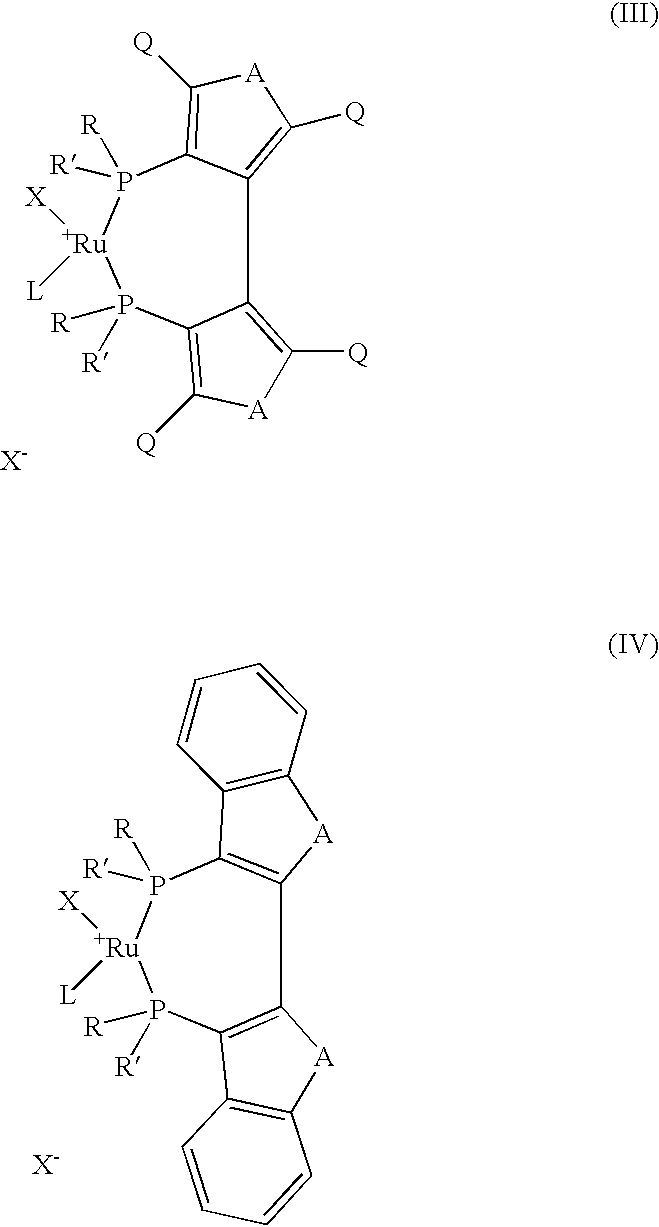Industrial process for the production of L-carnitine
a technology of lcarnitine and industrial process, which is applied in the direction of physical/chemical process catalysts, organic compounds/hydrides/coordination complex catalysts, organic chemistry, etc., can solve the problems of loss of 50% of the starting product, risk of imperfect reproducibility, and possible alterations of the strain used
- Summary
- Abstract
- Description
- Claims
- Application Information
AI Technical Summary
Problems solved by technology
Method used
Image
Examples
example 1
[0047] Preparation of {[Ru (p-cymene) I (+) TMBTP] I}
[0048] a) Preparation of [Ru I.sub.2 p-cymene].sub.2
[0049] Two g of [Ru CI.sub.2 p-cymene].sub.2 and 50 ml of methylene chloride are placed under nitrogen in a flask; 66 mg of tetramethylammonium iodide and subsequently an aqueous solution (50 ml) containing 10.2 mg of KI are added to the solution.
[0050] The mixture is left under vigorous stirring and in an inert atmosphere for approximately 15 hours at ambient temperature. The phases are separated. The aqueous phase is extracted with 2.times.40 ml of CH.sub.2Cl.sub.2. The gathered organic phases are washed with 3.times.40 ml of H.sub.2O, dried on Na.sub.2SO.sub.4 and filtered on dicalite. A red-brown solution is obtained which is vacuum-dried, 3.07 g of [Ru I.sub.2 p-cymene].sub.2 are obtained.
[0051] b) Preparation of {[Ru (p-cymene) I (+) TMBTP] I}
[0052] 155 mg of [Ru I.sub.2 p-cymene].sub.2 and 204 mg of (+) TMBTP are placed under nitrogen in a flask, and the mixture of 80 ml ...
example 2
[0053] Preparation of ethyl (+) (R)-4-chloro-hydroxybutyrate
[0054] 100 g of ethyl 4-chloro-3-oxobutyrate and 64.9 mg of {[Ru (p-cymene) I (+) TMBTP] I}, prepared in example 1, are placed under argon in a 3-liter reactor, in 1000 ml of ethyl alcohol degassed with argon; the mixture is heated at 120.degree. C. under argon and pressurised with hydrogen at 5 bar. After 3 h, the mixture is cooled, concentrated at reduced pressure, and the residue distilled with 5 mm Hg vacuum. 91 g of ethyl (+) (R)-4-chloro-3-hydroxybutyrate are obtained with an e.e. of 97% by gas-chromatography analysis.
[0055] Example 3: Preparation of L-carnitine
[0056] 8.4 g (0.05 mol) of ethyl (+) (R)-4-chloro-3-hydroxybutyrate and 23 ml (0.18 mol) of 45% trimethylamine in H.sub.2O are placed in a 50 ml-vial. The vial is closed with a rubber plug, sealed with a ring cap and maintained at 80.degree. C. for 24 h. At the end of the reaction the vial is cooled and opened. The aqueous solution is transferred to a flask, 2...
examples 4-7
[0059] Examples 4-7
[0060] The hydrogenation procedure described in example 2 was repeated, changing the S:C ratios (Table 1), or operating with catalytic amounts of base (Table 2).
[0061] The results obtained are as follows:
1TABLE 1 Hydrogenation reaction on 10 g catalyst:{[Ru(p-cymene) I (+) TMBTP]I} scale Test T P S:C % conv / t Conc. e.e. yield 4 120.degree. C. 5 bar 5000:1 100% / 30 min 10% 96% 97% 5 120.degree. C. 5 bar 10000:1 100% / 30 min 10% 96% 98% Legends: S:C: substrate:catalyst molar ratio % conv / t: percentage substrate reduced / time conc.: substrate concentration in reaction mixture e.e.: optical purity of reduced product
[0062] The results in Table 1 show that, when operating with the catalysts described in the present invention, and under the reaction conditions indicated, it is possible to obtain ethyl 4-chloro-3-hydroxybutyrate in high yields and with high-grade enantiomeric optical purity.
2TABLE 2 Hydrogenation reaction on 100 g catalyst:{[Ru(p-cymene) I (+) TMBTP]I} scale...
PUM
| Property | Measurement | Unit |
|---|---|---|
| pressure | aaaaa | aaaaa |
| molar ratio | aaaaa | aaaaa |
| molar ratio | aaaaa | aaaaa |
Abstract
Description
Claims
Application Information
 Login to View More
Login to View More - R&D
- Intellectual Property
- Life Sciences
- Materials
- Tech Scout
- Unparalleled Data Quality
- Higher Quality Content
- 60% Fewer Hallucinations
Browse by: Latest US Patents, China's latest patents, Technical Efficacy Thesaurus, Application Domain, Technology Topic, Popular Technical Reports.
© 2025 PatSnap. All rights reserved.Legal|Privacy policy|Modern Slavery Act Transparency Statement|Sitemap|About US| Contact US: help@patsnap.com



